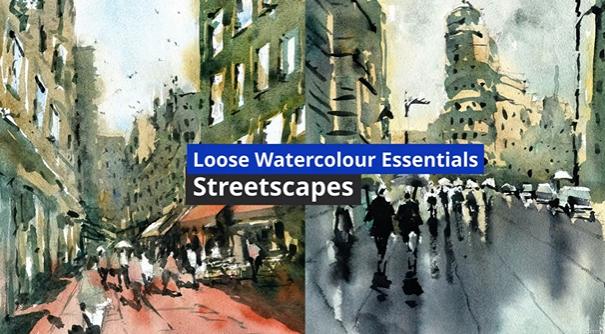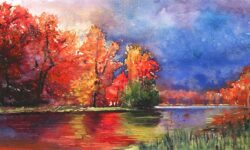Loose Watercolor Painting – Streetscapes by Darren Yeo (Watercolour Mentor)
Release date:2022, December
Author:Watercolour Mentor
Skill level:Beginner
Language:English
Exercise files:Yes
In this course, you will gain the following skills:
- Techniques for painting street cape scenes in watercolour
- Steps for sketching and planning your street cape painting
- Use of wet-in-wet watercolour techniques for painting clouds, skies, and land
- Adding people to landscapes in a simple manner
- Effective layering for added details
- Combining layers for natural depth
- Painting simple shadows and identifying a light source.
Prerequisites
No prior experience is required for this course. It is ideal for those who are new to watercolor painting as well as those with some intermediate level skills.
Course Overview:
This course is designed for anyone who wants to learn how to paint stunning streetcapes in watercolour. Whether you’re a beginner or an intermediate painter, this class is suitable for you.
By the end of this course, you’ll be able to create loose, spontaneous and expressive paintings of any streetcape in watercolour. With my guidance and simple techniques, you’ll learn how to simplify buildings, figures, cars, and shadows into basic shapes. You’ll also learn how to layer effectively, combine layers to create depth, and paint simple shadows.
This course is broken down into several lessons, and each lesson will focus on a specific aspect of painting streetcapes in watercolour. By the end of the course, you’ll have a complete understanding of how to paint a streetcape in watercolour.
Here is what you can expect to learn in this course:
- How to paint simple paintings of any streetcape in watercolour
- How to sketch and plan your street cape painting in pencil before you start painting
- How and when to use wet-in-wet watercolour techniques to paint clouds, skies, land
- How to add people into your landscape in a natural and simple way
- How to layer effectively to add extra details
- How to combine layers to create depth naturally
- How to paint simple shadows and identify or choose a light source in your painting
Get ready to dive into the world of streetcapes painting in watercolour. Let’s get started!
Assignment:
Your course project is to draw and paint your own streetscape in watercolour! This can be a scene featured in this course or based on one of your own photographs or scenes you have observed outside.
You can also refer to the scanned drawing/painting templates attached below which will allow you to trace the drawing if you choose to do so. I recommend drawing each scene freehand. Drawing is an important step in improving your painting skills. This provides you with an opportunity to compose and plan your painting. Once you’ve finished the drawing, use the watercolor steps and processes included in the course demonstrations to complete your painting.
As your final project, you’ll be tasked with creating your very own street cape painting in watercolour. This can either be a scene from this course or a street scene that you’ve captured in a photograph or personally observed. To help you get started, you’ll have access to scanned templates of the drawing that you can use as a tracing reference, or if you prefer, you can draw it freehand. Drawing is an integral part of the painting process and it provides you with the chance to plan and compose your painting. After completing the drawing, you’ll use the techniques and methods taught in the course demonstrations to create your beautiful watercolour street cape painting.
Project Assignment: Streetcape Watercolour Painting
The goal of this course project is for you to create your own street cape painting in watercolour. You can either follow the scenes featured in the course demonstrations or choose your own unique scene.
Materials:
For this project, you will need:
- 0.5mm mechanical pencil
- Artist-grade watercolour paints in blue, yellow, and red
- 100% cotton watercolour paper or sketchbook
- Watercolour brushes such as a mop brush and a variety of round brushes for detailing
Getting Started:
- Review the course demonstration videos first.
- If you wish, you can also download the tracing templates provided to help you transfer the drawing to your paper.
- If you prefer to paint a different scene, find reference photos online or take your own, or simply go outside and find a location to paint.
- Use the steps and processes taught in the course to create your own unique street cape painting.
Sharing Your Work:
- Share your final painting and progress shots with the course by uploading them to the Q&A and discussion section on Udemy.
- If you have any questions or need additional tips, feel free to ask in the discussion section. The instructor is happy to help.





 Channel
Channel





